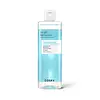What's inside
What's inside
 Key Ingredients
Key Ingredients

 Benefits
Benefits

 Concerns
Concerns

No concerns
 Ingredients Side-by-side
Ingredients Side-by-side

Water
Skin ConditioningButylene Glycol
HumectantDisodium Cocoamphodiacetate
CleansingPEG-6 Caprylic/Capric Glycerides
EmulsifyingUrea
BufferingPolysorbate 20
EmulsifyingSalicylic Acid
MaskingSodium Chloride
MaskingPEG-40 Hydrogenated Castor Oil
EmulsifyingAllantoin
Skin ConditioningSodium Glycolate
BufferingCentella Asiatica Extract
CleansingLactic Acid
BufferingDMDM Hydantoin
PreservativeSodium Hydroxide
BufferingDisodium EDTA
Propylene Glycol
HumectantHamamelis Virginiana Extract
AntiseborrhoeicGlycerin
HumectantMentha Piperita Oil
Masking1,2-Hexanediol
Skin ConditioningMelaleuca Alternifolia Leaf Oil
AntioxidantCitric Acid
BufferingSodium Benzoate
MaskingPotassium Sorbate
PreservativeWater, Butylene Glycol, Disodium Cocoamphodiacetate, PEG-6 Caprylic/Capric Glycerides, Urea, Polysorbate 20, Salicylic Acid, Sodium Chloride, PEG-40 Hydrogenated Castor Oil, Allantoin, Sodium Glycolate, Centella Asiatica Extract, Lactic Acid, DMDM Hydantoin, Sodium Hydroxide, Disodium EDTA, Propylene Glycol, Hamamelis Virginiana Extract, Glycerin, Mentha Piperita Oil, 1,2-Hexanediol, Melaleuca Alternifolia Leaf Oil, Citric Acid, Sodium Benzoate, Potassium Sorbate
 Reviews
Reviews

Ingredients Explained
These ingredients are found in both products.
Ingredients higher up in an ingredient list are typically present in a larger amount.
1,2-Hexanediol is a synthetic liquid and another multi-functional powerhouse.
It is a:
- Humectant, drawing moisture into the skin
- Emollient, helping to soften skin
- Solvent, dispersing and stabilizing formulas
- Preservative booster, enhancing the antimicrobial activity of other preservatives
Allantoin is a soothing ingredient known for its protective and moisturizingg properties. Because of this, it is often added to products with strong active ingredients.
Studies show higher concentrations of this ingredient can promote wound healing.
Though it can be derived from the comfrey plant, allantoin is produced synthetically for cosmetic products to ensure purity.
Learn more about AllantoinCitric Acid is an alpha hydroxy acid (AHA) naturally found in citrus fruits like oranges, lemons, and limes.
Like other AHAs, citric acid can exfoliate skin by breaking down the bonds that hold dead skin cells together. This helps reveal smoother and brighter skin underneath.
However, this exfoliating effect only happens at high concentrations (20%) which can be hard to find in cosmetic products.
Due to this, citric acid is usually included in small amounts as a pH adjuster. This helps keep products slightly more acidic and compatible with skin's natural pH.
In skincare formulas, citric acid can:
While it can provide some skin benefits, research shows lactic acid and glycolic acid are generally more effective and less irritating exfoliants.
Most citric acid used in skincare today is made by fermenting sugars (usually from molasses). This synthetic version is identical to the natural citrus form but easier to stabilize and use in formulations.
Read more about some other popular AHA's here:
Learn more about Citric AcidDisodium EDTA plays a role in making products more stable by aiding other preservatives.
It is a chelating agent, meaning it neutralizes metal ions that may be found in a product.
Disodium EDTA is a salt of edetic acid and is found to be safe in cosmetic ingredients.
Learn more about Disodium EDTAWater. It's the most common cosmetic ingredient of all. You'll usually see it at the top of ingredient lists, meaning that it makes up the largest part of the product.
So why is it so popular? Water most often acts as a solvent - this means that it helps dissolve other ingredients into the formulation.
You'll also recognize water as that liquid we all need to stay alive. If you see this, drink a glass of water. Stay hydrated!
Learn more about Water